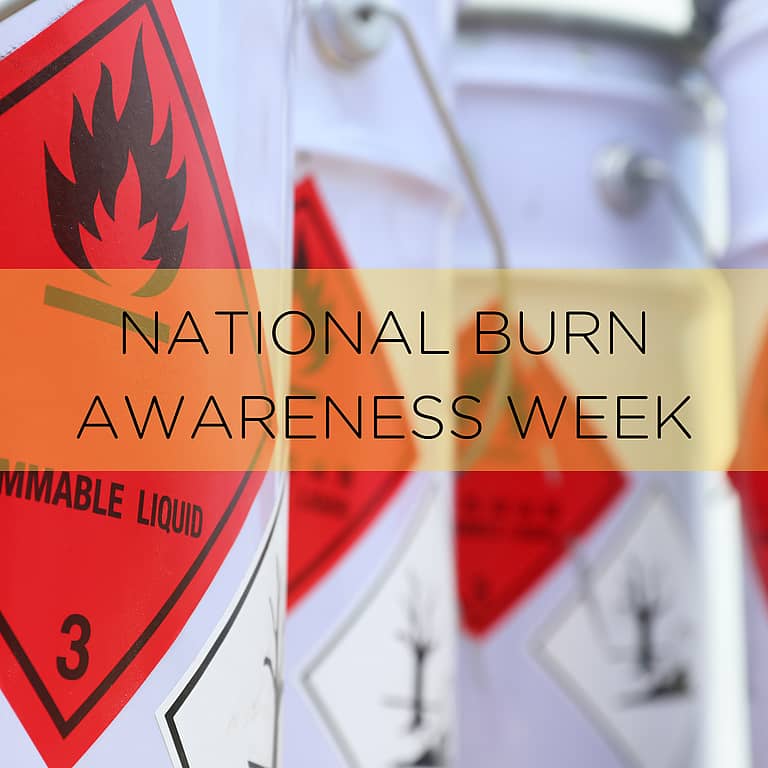This week (February 4-10, 2024) is National Burn Awareness Week, an event sponsored by the American Burn Association. The theme for this year’s campaign is preventing flammable liquid burn injuries. Burn injuries have been described as under-appreciated injuries that are associated with substantial morbidity and mortality.
National Burn Awareness Week highlights the importance of the safe handling of flammable liquids, both in the home and at work. Although most burns happen at home, a substantial number of burns occur each year in the workplace.
According to statistics presented by the Occupational Safety and Health Administration (OSHA), work-related fires and explosions account for more than 5,000 burn injuries each year. Studies show that up to 45% of burn injuries occur in the workplace and one study found that 40% of all burn fatalities were related to workplace fires and explosions.
Flammable liquids are among the most common hazards in a laboratory setting. The National Fire Protection Association (NFPA) defines a flammable liquid as a liquid with a flash point less than 100°F (38°C). The vapor of flammable liquids can readily ignite and burn in the presence of an ignition source. Because of this, flammable liquids must be used and stored properly.
The volume of flammable liquids in the laboratory should be minimized and must comply with the flammable storage permit, granted by the local fire department, which will define the total amount of material permitted on site. In addition, state and local building codes specify the Maximum Allowable Quantity (MAQ) of flammable liquids that may be used and stored in a control area.
Flammable liquids not in active use must be stored in cabinets or rooms designed for such storage. Cabinets must be equipped with metal doors that close and latch with three-way contact. They must not contain any ignition sources, such as electrical outlets, switches, motors, etc. They should be reasonably well sealed so that flammable vapors are contained and cannot easily travel to an ignition source. Flammable storage rooms must comply with building code requirements for rated walls, floors, ceilings and explosion proof lights, outlets and equipment.
Bonding and grounding must be addressed for all transfer of flammable liquids. Electrical charges are developed whenever liquids that are poor conductors are transferred from one container to another. Electrical charges can build up on personnel wearing rubber or plastic soled shoes. Charges are also developed when compressed gases are released rapidly from a cylinder. When these charges become high enough, they jump air gaps forming sparks which may ignite flammable vapors. Discharge could cause fire or an explosion. Grounding vessels and equipment will prevent this; always connect the container and receiver by a ground wire. It is also a good idea to ground a person working with greater than 2 gallons of flammables by using a wrist strap, grounded shoes, or a grounding shoe strap.
The following additional precautions should be observed when storing and using flammable liquids: Use safety cans, wherever possible, for storing flammable liquids
- Store all flammable liquids in tightly sealed containers
- Segregate flammable liquids from strong oxidizers such as chromic acid, permanganates, chlorates, perchlorates, and peroxides
- Use a fume hood when handling flammables
- Do not store flammable liquids in standard lab refrigerators; as we talked about in a recent blog, they must be stored in flammable safe or explosion-proof refrigerators
- Do not place flammable liquids in sunlight, near heat sources, or other similar devices, or where vapor may travel to a source of ignition
- NEVER heat flammables with an open flame; heating mantles, oil baths, and safety hot plates should be used; boiling chips and glass beads are helpful in distilling or evaporating flammable liquids, to prevent super-heating and bumping
- Flame resistant lab coats should be worn when handling highly flammable materials; avoid wearing clothing made of synthetic materials like polyester
The American Burn Association has put together resources you can use in your organization to promote Burn Awareness and Prevention Week including fact sheets, posters, and social media posts. The NFPA also has additional materials for use in sharing the burn awareness and prevention message in the workplace and in our communities.
For additional information on National Burn Awareness Week, or for assistance in putting a safety program in place at your facility to prevent burn injuries, please contact us.
This blog was written by Beth Graham, Director of Quality, Research, & Training at Safety Partners.


